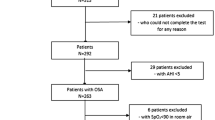Abstract
In this study, we evaluated the gender differences in body mass index (BMI), age and their effects on apnea–hypopnea index during total sleep time (AHITST) in the Turkish population who were diagnosed with obstructive sleep apnea syndrome (OSAS) and compared them with data from the literature. A computerized database of 244 Turkish patients (194 males, 50 females) who had undergone overnight polysomnography (PSG) and diagnosed with OSAS at Bayındır Hospital sleep laboratory between October 2004 and January 2007 was reviewed. The male:female ratio of the patients was 3.88:1. Male patients were significantly younger compared to females (48.87 ± 10.82 vs 52.94 ± 12.14 years, respectively, P = 0.003). The BMI and AHITST were similar in male and female patients (BMI = 29.52 ± 4.63 vs 31.17 ± 6.08 kg/m2, respectively, P = 0.083) (AHITST = 27.45 ± 22.97 vs 24.77 ± 23.83, respectively, P = 0.149). For the male and female groups, AHITST increased as BMI increased (P = 0.03, 0.04). The median values of AHITST in male group, for the normal, overweight and obese + pathological obese groups were 12.45, 20.20 and 23.50, respectively, whereas the median values of AHITST in female group were 11.10, 10.95 and 26.20, respectively. In the normal and obese + pathological obese groups, there was no statistically significant difference according to gender, whereas in the overweight group, male patients had significantly higher AHITST (P = 0.02). There was no statistically significant difference between the male and female patients regarding the severity of OSAS (P = 0.358). However, there was a male tendency to moderate and severe OSAS in the normal and overweight BMI groups. In Turkish patients with OSAS, there was no gender difference in BMI and AHITST and female patients were significantly older than the males. The OSAS was diagnosed in men nearly four times more often than in women.
Similar content being viewed by others
References
Kapsimalis F, Kryger MH (2002) Gender and obstructive sleep apnea syndrome, part 2: mechanisms. Sleep 25(5):497–504
AASM Task Force (1999) Sleep-related breathing disorders in adults: recommendations for syndrome definition and measurement techniques in clinical research. Sleep 22(5):667–689
Walker RP, Durazo-Arzivu R, Wachter B, Gopalsami C (2001) Preoperative differences between male and female patients with sleep apnea. Laryngoscope 111:1501–1505
Vagiakis E, Kapsimalis F, Lagogianni I, Perraki H, Minaritzoglou A, Alexandropoulou K, Roussos C, Kryger MH (2006) Gender differences on polysomnographic findings in Greek subjects with obstructive sleep apnea syndrome. Sleep Med 7:424–430
Young T, Hutton R, Finn L, Badr S, Palta M (1996) The gender bias in sleep apnea diagnosis. Arch Intern Med 156:2445–2451
Shepertycky MR, Banno K, Kryger MH (2005) Differences between men and women in clinical presentation of patients diagnosed with obstructive sleep apnea syndrome. Sleep 28(3):309–314
Kapsimalis F, Kryger MH (2002) Gender and obstructive sleep apnea syndrome, part 1: clinical features. Sleep 25(4):409–416
Mohsenin V (2001) Gender differences in the expression of sleep-disordered breathing. Role of upper airway dimensions. Chest 120(5):1442–1447
Ware JS, Reuben H, Scott JA (2000) Influence of sex and age on duration and frequency of sleep apnea events. Sleep 23(2):1–6
Rechtschaffen A, Kales A (1968) A manual of standardized terminology, techniques and scoring system for sleep stages of human subjects. National Institutes of Health US Government Printing Office, Washington, DC [Publication no. 24]
O’Connor C, Thornley KS, Hanly PJ (2000) Gender differences in the polysomnographic features of obstructive sleep apnea. Am J Respir Crit Care Med 161:1465–1472
Dancey DR, Hanly PJ, Soong C, Lee B, Shepard J, Hoffstein V (2003) Gender differences in sleep apnea. Chest 123(5):1544–1550
Bixler E, Vgontzas A, Lin HM (2001) Prevalence of sleep disordered breathing in women. Effect of gender. Am J Respir Crit Care Med 163:608–613
Guilleminault C, Quera-Salva MA, Partinen M, Jamieson A (1998) Women and obstructive sleep apnea syndrome. Chest 93(1):104–109
Huang J, Shen H, Takahsi M (1998) Pharyngeal cross-sectional area and pharyngeal compliance in normal males and females. Respiration 65:458–468
Author information
Authors and Affiliations
Corresponding author
Rights and permissions
About this article
Cite this article
Bozkurt, M.K., Öy, A., Aydın, D. et al. Gender differences in polysomnographic findings in Turkish patients with obstructive sleep apnea syndrome. Eur Arch Otorhinolaryngol 265, 821–824 (2008). https://doi.org/10.1007/s00405-007-0554-z
Received:
Accepted:
Published:
Issue Date:
DOI: https://doi.org/10.1007/s00405-007-0554-z




